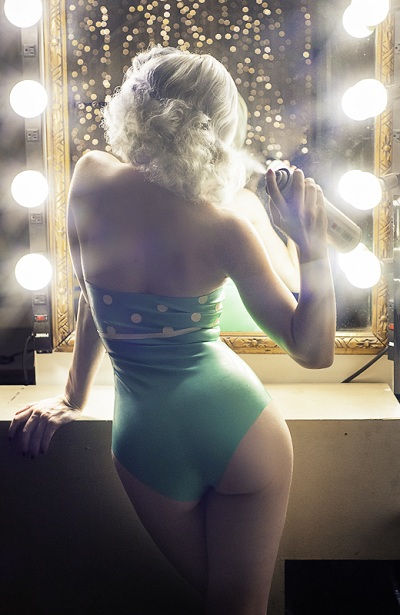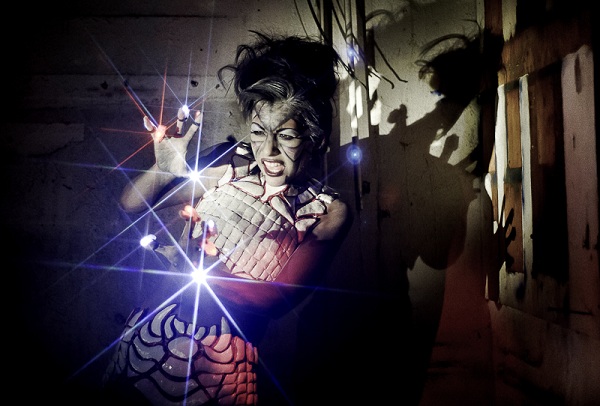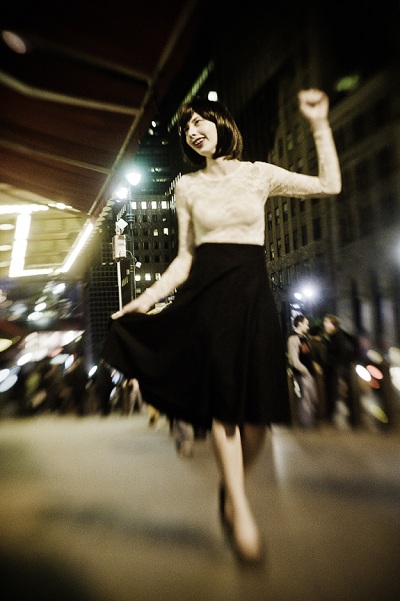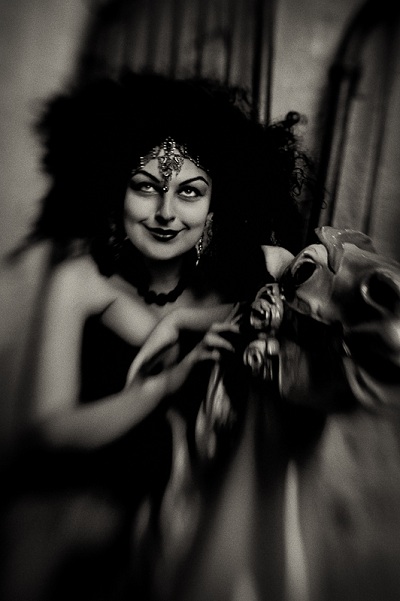In-Camera Manipulations
In the last MM Edu article I wrote I discussed mixed media manipulation as a “real world” alternative to spending time in Photoshop to make images fancy. This time we’ll look at some of the in-camera alternatives to post-processing manipulation.
It’s worth noting that all of these effects are time-tested, some going back to the very dawn of photography in the 1830s. Done properly, they still look and feel as fresh as any of the latest Photoshop plugins.

Photographer: David Miller; Model: Mosh
“Mosh at a makeup station is going to make a good photo no matter what, but the star filter gave a little extra glam “pop” to the station lights.”
Controlling time
The camera controls exposure via the aperture, the ISO setting, and the shutter speed, and it’s this last factor that can create the simplest of the special effects. The shutter allows the photographer to control the amount of time that passes when an image is captured, so we can have a lot of time pass–resulting in a blurry image if the camera is handheld, or there are moving subjects in front of it–or we can shorten the length of time–making some objects freeze that wouldn’t normally be visible to the naked eye. Simple enough, right?
Throw some flash while shooting with a slow shutter speed and an effect called “dragging the shutter” occurs. It’s generally how we see these images showing, say, a baseball player in motion, with the player frozen, but a subtle blur of where he used to be.
If you are dragging the shutter– say, 1/15th of a second shutter speed– and zoom your lens, or pan quickly to the side, you’ll see even stranger effects. “Strange” as in Star Wars or 2001: A Space Odyssey style “strange.”

Photographer: David Miller; Model: Angel my Darling
“This was dragging the shutter at 1/15th of a second with only the on camera flash for illumination. I moved the camera sideways while the shutter was open, causing the horizontal blurring.”
A more complex way of capturing multiple images in one frame, without blurring, is to use powerful strobes that fire at intervals within a darkened space. The best examples of this style are the work of Dr. Harold Edgerton in the mid-20th Century. Definitely worth a Google.

Photographer: David Miller; Model: LiiLii
“Another case of dragging the shutter, but with multiple flashes aimed at the model’s head, and a smaller aperture. The water around her head was frozen while the water away from her is flowing.”
If your subject is stationary during a long shutter speed exposure, but lights a Maglite with a gel on it, or even a colored cell phone screen, and moves it around, that’s called light painting.

Photographer: David Miller; Model: Sheila Miss Electro
“Light painting is a variation of dragging the shutter where colored lights “paint” a subject, or scene. This was all club lights but a more controlled variation could look unearthly.”
Changing the light that comes through your lens
The most common way to alter the light as it passes into a lens is via filters, those little glass circles that everyone is supposed to have on their camera. Common filters reduce haze, UV, glare, etc. but there are specialty filters that more radically alter the light coming in.
A star filter creates starry lighting effects that you might associate with cheesy 1980s Christmas TV specials, but they were popular in their heyday for a reason–people like shiny, sparkly things. Lens flares may be anathema in stock photography but interesting flaring is common enough in fashion; besides sparkles, the crosshatching on the filter glass causes unusual flares when light hits from oblique angles. The hatching shape determines the number of points on the stars in the photo.

Photographer: David Miller; Model: Lux Lacheln
“The finger lights Lacheln is wearing are goofy in real life but give her E.T. powers thanks to the star filter on my lens.”
Prism filters are somewhat costly and less versatile. They break up a single image into multiple images similar to a kaleidoscope. Instant psychedelia. It’s a thick chunk of glass that reduces edge fidelity, and is someone what difficult to use. Suddenly, instead of composing one image, it’s composing three images across the frame, and composition rules like “rule of thirds” and “leading lines” can no longer apply.

Photographer: David Miller; Model: Sierra McKenzie
“Sierra is split with a 3-way prism filter. The hologram on her glasses is from using a $3 WalMart display board as a reflector.”
There are many other specialty filters, more than I have the space to list. Bokeh filters give specific shape to the points of light that bleed through your images–so if for whatever reason, you wanted all those lights in the background to be hearts instead of lights, there’s a way to do it. A neutral density filter acts as sunglasses for your camera–allowing you to slow the shutter speed in the brightest of daylight. See the section on “controlling time” for reminders on how that is a useful effect.
Basically, anything you place in front of your lens is going to shape the light for the good, the bad or the interesting. Saran wrap, drier sheets, a glass block from Home Depot, a glass of water…
Bending the lens
A less common way of altering the light is to bend it in relation to the camera body. The simplest way of accomplishing this is removing your lens and holding it close to the lens mount as you take a photo. Not all cameras allow a photo to be taken without the lens actually attached, and it could get dirt on your sensor to work this way, so a more precise version of this technique is a Lensbaby. There are various models but they all function with a “sweet spot” of central focus, with the rest of the image rapidly blurring. It’s a fun lens that helps dissolve distracting elements, like a vending machine or people walking behind your scene.

Photographer: David Miller; Model: Nika
“The Lensbaby cleaned up this image a lot by disregarding all the bystanders and cars on a busy NY street. It also gave the model, who is standing still, the illusion of motion.”
If you’re very serious about perspective control, a costly tilt/shift lens may need to be on the Christmas list. For SLR cameras, the tilt/shift lens has knobs that separate the front end of the lens barrel from the rear. If the front glass remains parallel to the sensor, you can correct the way buildings appear to recede when photographing them. If the front glass is at an oblique angle to the sensor, you can get a similar effect to the Lensbaby. Large format cameras have tilt/shift built into their design–it’s that fancy accordion bellows that everyone remembers.

Photographer: David Miller; Model: Anastasia Arteyeva
“Anastasia specifically requests I shoot her with the Lensbaby because she’s such a fan of its look.”
Merging within the camera
Double exposure is always a classic. It’s two (possibly more) shots on one frame, accessible through the camera menu. If you utilize a Lomography-type camera, some allow overlapping of film frames, leading to pseudo-double exposures or jagged panoramic. Some digital cameras have panoramic features to them as well.
Smartphone’s have blurred the line between what is “in camera” and what is considered post-work, but for the traditional SLR/DSLR user, these tools are a means of creatively widening a personal vision.




December 02, 2012 at 7:49 pm, Ben Hinman said:
You forgot tilt shift and effects lenses! 🙂 My lensbaby composer offers some cool focal distortion that even makes bent bokeh
December 02, 2012 at 7:50 pm, Ben Hinman said:
Oh wait, my bad. You did mention lensbaby.
November 29, 2012 at 4:56 pm, Ruben said:
Thanks for the creative insight. Awesome work!!
November 29, 2012 at 1:02 pm, zincphoto.com said:
Great creative article and very nice job explaining things. Thanks!